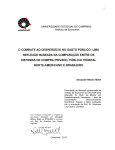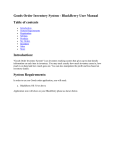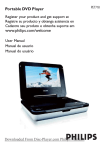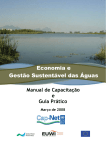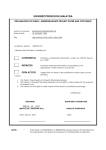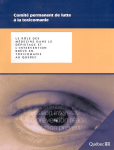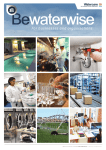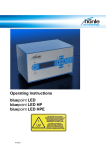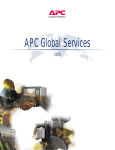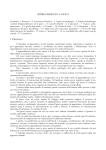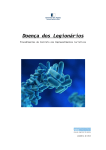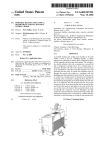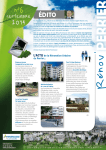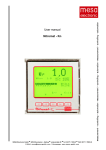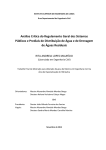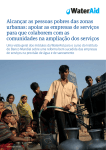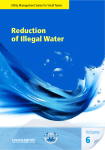Download Water Safety Plan Quality Assurance Tool
Transcript
User Manual Water Safety Plan Quality Assurance Tool <2 C o n te nts section section section A Abo ut the to o l B U si ng the to o l C C ASE ST U DY FOR U SING T HE TOOL 21 6 11 <4 Ov e rvie w Why use this Tool? To increase confidence that safe water is consistently being delivered to consumers by ensuring that key elements in the WSP process are not overlooked and that the WSP remains up to date and is effective. Who should use this Tool? The WSP team set up by the water supplier or similar entity managing organized drinking-water supplies. When should the Tool be used? The Tool is likely to be of most benefit when applied at intervals dictated by the pace of WSP implementation. At a minimum, it should be used once per year. How long does the Tool take to complete? The Tool should not take more than a day to complete but it could well take longer if the supplier has several water supply systems and until the WSP team has become more experienced in its use. 5> <6 Water Safety Plan Quality Assurance Tool User Manual section A A b o ut th e tool 7> section A about the toOl 1. Introduction Since the launch of the 3rd edition of the WHO Guidelines for Drinking-water Quality and the IWA Bonn Charter for Safe Drinking Water in 2004, which both advocated the implementation of Water Safety Plans (WSPs), there has been a global shift in how water supplies are managed. WSPs provide a risk based, preventative approach to managing drinking-water safety from catchment-to-consumer. Effective implementation of WSPs can contribute to safeguarding public health, improving regulatory compliance, operational efficiency gains and better targeted investments. Such benefits are only realized through sustained efforts and continuous improvements of the WSP. To this end, there is a need to develop mechanisms whereby a water supplier can objectively assess WSP implementation and identify areas of progress and areas for improvement. The WSP Quality Assurance Tool aims to meet this need and support WSP teams to develop, implement and assess WSPs. The major benefits for water suppliers in applying the Tool will be the systematic highlighting of: • Areas where progress is being made and; • Opportunities for improvements. Other benefits of using the Tool include: • • • • • • • Application as a guidance tool when initially developing and implementing a WSP; Protecting against complacency after WSP initially implemented; Facilitating reporting, both internally and externally (Tool generates summary reports); Identification of problems due to staff turnover and loss of institutional memory; Highlights and helps to prioritize areas of concern that need improvement; Helps to monitor progress over time of previously highlighted areas of concern; Helps to justify areas where investment may be required to make improvements. 2. Who Should Use the Tool? The Tool should be used by the WSP team set up by the water supplier to oversee its WSP implementation. If this team includes external expertise, representatives of other stakeholders or other parties, these should be included. The Tool can also be used by senior management and internal assessors as a means of monitoring WSP activities of the water supplier. Where a water supplier is only responsible for part of a water supply system, for example abstraction and treatment or distribution, or it receives a bulk supply from another supplier, its WSP team should work with the teams from the other water suppliers so that the Tool is completed from catchment to point of use for each water supply system. This will allow for greater understanding of the complete system and how each entity operates and also ensures that hazards are identified at entity boundaries that could otherwise be missed or not understood. 3. When Should the Tool be Used? The Tool is universally applicable in a range of circumstances, for water suppliers beginning to implement WSPs to those who have had WSPs in place for some time. The Tool is likely to be of most use when utilized at intervals dictated by the pace of WSP implementation. When applied at the early stages of WSP development, the Tool will guide and assess implementation. It will assist in identifying areas of weakness and highlight where efforts need to be targeted. For those suppliers that have already implemented a WSP, this Tool will also help to challenge complacency to ensure that the WSP remains up to date and is effective. <8 SeCTion A Water Safety Plan Quality Assurance Tool User Manual Fig.1 - Application and Usefulness of the Tool at Various Stages of WSP Implementation Development of WsP implementation of WsP ongoing review of WsP Ensure essential elements of WSPs are not overlooked Monitor progress & identify areas for improvement Monitor progress & areas for further improvement Helps to ensure that the WSP remains up to date Evaluate effectiveness of WSP SeCTion B SeCTion C Time / WsP maturity 4. Structure of the Tool For clarity and ease of use, the Tool has been divided into two sections split into twelve tables. Each table consists of a series of questions. Each question includes some guidance on how to answer it with further guidance available in the WSP Manual and other references. Part 1 consists of two tables: Table 1 - General information on the water supplier Table 2 - General information on water supply system Part 2 consists of ten tables related to the WSP approach. For ease of use, these tables are structured around the steps identified in the WHO/IWA WSP Manual (Bartram et al., 2009) (http://www.who.int/water_sanitation_health/publication_9789241562638/en/index.html) and knowledge and understanding of this Manual are essential prerequisites for proper application of the Tool. Table 3 - WSP Team Table 4 - System Description Table 5 - Hazard Identification and Risk Assessment Table 6 - Control Measures and Validation (including reassessment and prioritization of risks) Table 7 - Improvement Plan Table 8 - Operational Monitoring Table 9 - Verification Table 10 – Management Procedures Table 11 – Supporting Programmes Table 12 – Review of the WSP (including periodic reviews and following incidents) 9> secTion A ABoUT The Tool 5. Using the Tool to Support Implementation The scoring is a simple system of five points (0-4) where a step can be described from being ‘not started’ to ‘fully completed’; this range is described in more detail in section B. It is not the intention to put too much emphasis on the exact scores obtained. Where the scoring should be helpful is to point to areas where improvement should be made and where priorities should be directed and with regular use of the Tool to show the water supplier and others involved with the WSP process that progress is being made with WSP implementation over time. It also allows for easy reporting of progress to all within the water supply including senior management. The Tool allows a water supplier to assess multiple water supply systems and therefore, it enables direct comparison of results in easy to view table and graphical formats. It also allows for direct comparison of WSP implementation over time between systems and within a system. These summary tables and graphs will assist the water supplier in gaining an understanding of their overall performance against each WSP step. The WSP team may also find these results a useful resource when communicating to senior management; for example, to indicate where further resources are needed and to demonstrate that progress with water safety planning is being made. It should be stressed that the WSP Tool will not determine what appropriate actions should be taken. The Tool will point to areas that need improvement, but it is up to the water supplier to determine how best to achieve the step. < 10 SeCTion A Water Safety Plan Quality Assurance Tool User Manual SeCTion B SeCTion SeCTion C B U Sin g T h e Tool 11 > section B USING THE TOOL 1. Prerequisites The scope and layout of the Tool is closely aligned to the WSP, it is therefore essential that the WSP concepts described in the Manual are understood before application of the Tool. Furthermore, it is recommended that the following are also considered before its use: 1. E nsure that management is supportive and has allowed resources to be freed up for the duration of the assessment exercise; 2. Gather together the team that is responsible for overseeing WSP implementation including external expertise, representatives of external stakeholders and other bodies. For some questions other individuals who are not part of the WSP team but influence the WSP process may need to assist the team but only if this is a role they have already undertaken as part of the WSP development. It is recognized that not all members of the WSP team may be needed to complete each table and it may help to identify only the relevant members to evaluate each table of the Tool if there is a time constraint. Drawing up a schedule or agenda will assist with efficiency; 3. Identify and gather the necessary resources to complete the evaluation. This includes having copies available of the WSP Manual and the Tool. It is also recommended that an assessment coordinator and rapporteur(s) are designated. The coordinator would be responsible for leading the above prerequisite activities as well as facilitating discussions as the Tool is being applied. Rapporteur(s) would be responsible for filling in the Tool during the assessment period. Note that resourcing for each assessment will depend on the extent and complexity of the water supply system or systems being covered and the depth of assessment required. It is anticipated that the Tool should not take more than a day to complete but it could well take longer if the supplier has several water supply systems and until the WSP team has become more experienced in its use. It is not necessary for the WSP team filling out the Tool to go through the supporting information (in the form of records, diagrams, documents, electronic databases, etc.) if they can answer the questions without them. However, the information should be available or easily accessible and the team may wish to refer to this information, especially when the team cannot easily answer a question or agree upon an answer. 2. Starting the Application If you are using the CD-ROM version of the tool, you will see the main page as shown in Figure 2. From here you can navigate directly to the tool, or select other useful references. Macros Please note that the Tool contains macros. If macros are disabled, a warning note will appear on the menu page of the Tool. To enable macros when using Excel 2003 version: 1. Go to the Menu Bar and select ‘Tools’; 2. Move the cursor over “Macro” and select “Security”; 3. From the options, select “Medium” and then select “Ok”; 4. Close the file and re-open it. You will receive a security warning. Select “Enable Macros”. This will allow all the features of the Tool to be fully active. < 12 SeCTion A Water Safety Plan Quality Assurance Tool User Manual To enable macros when using Excel 2007/2010 version: 1. Go to the Round Office button in the top left corner. 2. Select “Excel Options”. 3. Select “Trust Center” and then “Trust Center Settings”. 4. Select “Disable all macros with notification” and click “Ok” twice. Fig.2 - CD-ROM Main Page SeCTion B SeCTion C 3. Enter Assessment Page At the top of the screen you will see the twelve tables listed (see field 1 in figure 2). Each table can be viewed once selected and accordingly, can be updated with your assessment information (see field 2 in figure 4). 13 > section B using the tool 4. Scoring As noted in the WSP Manual, there is no one way to undertake the WSP approach. Therefore, the questions specific to WSP development and implementation in Tables three to twelve do not specify how a water supplier should operate. The WSP Manual should be referred to for examples on some practices that have been found effective for some water suppliers. It is important that all questions are reviewed in even though that particular action has not yet been started. Additionally, in line with the WSP Manual approach, the questions are in sequence and a previous step may need to be completed before the next step can also be completed. An obvious example of this is that risk assessment cannot be marked as fully completed until hazard identification and control identification and validation have been fully completed. Responses to the questions in Tables three to twelve are generally in a drop down list format with a zero to four grading scale. It is important that a water supplier’s responses are an honest and self-critical appraisal of the progress it has made. • • • • • A score of zero should be given to steps that have not been started; One point should be given to steps which have just started; Two points should be given to steps that have been partially completed and documented; Three points should be given where the step has been substantially completed and documented; and Four points should be given where the step has been fully completed and documented and evidence of this is readily available. Guidance is given for each question on what would merit a score of four points. “Not started” and “just started” should be self explanatory but it will be for the water supplier to decide if a score of two points or three points is merited. In some cases, these general definitions do not apply and therefore, more specific guidance has been provided for those questions. Additionally, where applicable, some questions also have a “not applicable” (NA) rating in addition to scores. A cumulative total for each table is given at the bottom of the table (see field 3 in figure 4). However, It is not the intention to put too much emphasis on the exact scores obtained. In fact, it is unlikely that many questions will merit four points until WSP implementation has been in place for some time. Even in these cases, there should generally be room for improvement and therefore, it is likely that the top score will not be achieved for all questions. If the total scores are very high, the water supplier may find it helpful to arrange for an independent external evaluation with the Tool. Furthermore, as water safety planning is an iterative process, obtaining top scores is not an end in itself and it’s imperative that the WSP is continually reviewed and assessed to ensure that the WSP remains up to date and effective. The Tool can be adapted to suit your particular needs; in particular, new questions can be added to the Tool by use of the ‘Create a New Question’ button (see field 4 in figure 2). There are two types of questions that can be generated; one is a ‘general’ question, which is not scored and the other is an ‘assessment type’ question, which will be added to your cumulative score for that table. For assessment type questions created in tables three to twelve, the scoring is restricted to zero to four for consistency with the rest of the tables. The definitions for these scores should be placed in the comment fields and the scoring for these new questions will be accounted for in a row below the total score. Any guidance that is needed for these questions should also be entered in the comment fields. To differentiate between these new questions and the existing questions within the Tool, the text of the new questions will be listed in a different colored font. Quantitative questions The response to some questions is in the form of outputs, for example number of stakeholders identified, number of hazards identified and number of operational tests carried out. These questions are optional and are not scored. However, the information provided will help the water supplier to further measure its progress with WSP implementation over time since it allows for the assessment of various parameters and should be a means < 14 SeCTion A Water Safety Plan Quality Assurance Tool User Manual of demonstrating improvements linked to WSP implementation such as an increase in the number of controls validated, a reduction in the number of incidents and fewer quality results outside of operational limits. Also, this will enable senior management or an external assessor to gain insight into the magnitude and complexity of each WSP. SeCTion B Within Tables 1-12, the WsP QA Tool uses the following colors to distinguish the different types of information Light orange cells indicate fields that need to be filled in based on the question in the cell to the left. SeCTion C Light grey cells should be used to enter comments. You may wish to use this space to explain why a particular answer has been given or to act as an aide memoire for the next time the assessment is completed. It may be helpful to enter the names and job titles of the persons entering comments, especially if they differ from those completing the Tool. Light blue cells include calculations based on the answers provided in the light orange cells. The information in these cells cannot be changed. Dark grey cells indicate that an assessment for that particular question is not needed. The question is currently not applicable based on answers provided in previous, dependent questions. To obtain maximum benefit from the Tool, it is suggested that these questions are also reviewed. Red cells indicate that the assessment conflicts with an answer provided in previous, dependent questions. Please read the associated comment and update your assessment accordingly. Comment fields It is important that full use is made of the comment fields see field 7 figure 2 when answering the questions in the Tool. These can be used to justify a score when the water supplier is not completely sure of which score to award; to explain a supplier’s interpretation of a question where it is unsure of the meaning or terminology; to explain why a question has not been completed; to document the evidence used to justify a score etc. This will enable the comments to act as an aide memoire for the next time the Tool is completed. The comment fields should also be utilized when a score of “partially completed” or “substantially completed” is entered. These scores are more subjective and the comments can facilitate consistency in the scoring approach during future assessments. Guidance and references Because each step comes from the recommendations in the WSP Manual, further details on each step listed in the Tool can be found in the WSP Manual and other references. To ease use of the Tool, some guidance, which is located in the pop-up note that accompanies each question, has also been included. These guidance notes may include: • • • • • Further explanation of the question; Definitions of terms; Rationale for the importance of each step; Some details of the WSP step; References to where further information can be found, including the location within the WSP Manual (second tab within the pop-up note). 15 > section B using the tool Fig.3 – Overview of Assessment Tool Fields Field 6 View output charts and tables Field 4 Creating a new question Field 1 Select table to complete Field 3 Cumulative score for table Field 5 Start new assessment Field 2 Insert assessment response Field 7 Insert comments 5. Saving and updating Whilst using the Tool it is highly recommended that you save at regular intervals. If the Tool is obtained from the CD-ROM, the excel file should be saved on your hard drive and not on the CD-ROM. The Tool will be of most benefit when used periodically over time to track progress, improvements and areas of concern. You can create a new assessment for each table by clicking on the ‘Create New’ button under the Assessment heading (see field 5 in figure 4). This feature enables the user to conduct assessments and compare performance over time and also compare performance between different water supply systems over a similar time period. In the latter case, the tables that are general to the water supplier (one, three, ten and eleven) only need to be assessed once. However, in order to compare these systems in the summaries, it is advised that each table is still filled out by copying the answer from the first assessment. < 16 SeCTion A Water Safety Plan Quality Assurance Tool User Manual 6. Summary Tables and Graphs Once you have finished completing the assessment, you can click on the ‘View Results’ button (see field 6 on figure 4), which will automatically generate summary tables and graphs for your assessment. These summary tables and graphs will assist the water supplier in easily identifying where efforts should be targeted and where progress has been made. The WSP team may also find these results a useful resource when communicating to senior management; for example, to indicate where further resources are needed and to demonstrate that progress with water safety planning is being made. SeCTion B SeCTion C The summary tables display the information included in tables one to twelve in a numerical format. This includes the answers provided for both the scoring and quantitative type questions. These tables have been organized by general information (derived from tables one to two), by WSP step (derived from tables three to twelve) and by water supply component (derived from tables three to twelve). For the latter two summaries, the tables also include information on the number of questions within each summary, the total possible points as well as the actual score achieved. These summaries do not reflect the additional questions and corresponding scores that may be added by the water supplier. The summary graphs display the scoring type information included in tables three to twelve in a chart format where the results can be viewed by WSP step and by water supply component. The user may wish to refer to the summary tables for further details on how these graphs were derived. Summary tables and graphs for completed assessment General water supplier information Number of water supply systems % Population obtaining water from supplier % Water supply systems covered by a WSP that is being developed and/or implemented % Water supply systems covered by a WSP that has been fully implemented % Population obtaining water covered by a WSP that is being developed and/or implemented % Population obtaining water covered by a WSP that has been fully implemented % Consumers obtaining water covered by a WSP that is being developed and/or implemented % Consumers obtaining water covered by a WSP that has been fully implemented % Staff involved in WSP development and implementation Supply specific information Responsibility for catchment Responsibility for raw water sources Responsibility for treatment Responsibility for distribution Responsibility for consumer premises Number of incidents that have occurred in the past year % Water loss within the distribution system in the past year % Population obtaining water from system 17 > section B using the tool Overall progress with WSPs (Tables 3-12) No. of questions Total possible raw score Score Table 3 - WSP team 5 20 0/20 (0%) Table 4 - System description 2 8 0/8 (0%) Table 5 - Hazard identification and risk assessment 7 100 0/100 (0%) Table 6 - Control measures and validation 5 68 0/68 (0%) Table 7 - Improvement plan 3 48 0/48(0%) Table 8 - Operational monitoring 4 64 0/64 (0%) Table 9 - Verification 8 32 0/32 (0%) Table 10 - Management procedures 3 36 0/36 (0%) Table 11 - Supporting programmes 2 8 0/8 (0%) Table 12 - Review of the WSP 5 56 0/56 (0%) 44 440 0/440 (0%) Table Total Quantitative information < 18 No. of stakeholder groups identified 0 No. of stakeholder groups contacted 0 No. of hazardous events identified 0 No. of controls identified that are in place 0 No. of controls identified that are needed 0 No. of controls validated as effective 0 No of improvement programmes developed 0 No. of improvement programmes being implemented 0 No. of controls subject to operational monitoring 0 No. of micro tests water required or planned w/in past year on source water 0 No. of micro tests carried out w/in past year on source water 0 No. of micro tests carried out w/in past year on source water that met supplier’s defined limits 0 No. of physical, chemical and radiological tests required or planned w/in past year on source water 0 No. of physical, chemical and radiological tests carried out w/in past year on source water 0 No. of physical, chemical and radiological tests on source water carried out w/in past year on source water that met supplier’s defined limits 0 No. of micro verification monitoring tests required or planned w/in past year 0 No. of micro verification monitoring tests carried out w/in past year 0 No. of micro verification monitoring tests carried out w/in past year that met water quality targets 0 No. of physical, chemical and radiological verification monitoring tests required or planned w/in past year 0 No. of physical, chemical and radiological verification monitoring tests carried out w/in past year 0 No. of physical, chemical and radiological verification monitoring tests carried out w/in past year that met water quality targets 0 SeCTion A Water Safety Plan Quality Assurance Tool User Manual SeCTion B Quantitative information % Stakeholders contacted % Controls validated as effective % Improvement programmes being implemented SeCTion % Controls subject to operational monitoring C % Micro tests on source water that met monitoring freq targets w/in past yr % Micro tests on source water that met supplier’s defined limits w/in past yr % Physical, chemical and radiological tests on source water that met monitoring freq targets w/in past yr % Physical, chemical and radiological tests on source water that met supplier’s defined limits w/in past yr % Micro tests met verification monitoring freq targets w/in past yr % Micro tests met water quality targets w/in past yr % Physical, chemical and radiological tests met verification monitoring freq targets w/in past yr % Physical, chemical and radiological tests met water quality targets w/in past yr Exporting Assessment Reports The reports can be generated in both Microsoft® Word and PowerPoint format. The results can also be exported into a separate Excel file. Unlike the reports within the Tool, the data within the exported Excel file can be reformatted and therefore, customized to meet individual water supplier needs. The user may also wish to generate the results in Word so that comments can be entered easily below each summary chart or graph. Lastly, the export to PowerPoint feature allows the water supplier to kick-start development of a presentation, if that is desired. Hasard identification and Risk Assessment Score (% implemented) 100% 90% 80% 70% 60% 50% 40% 30% 20% 10% Score (% implemented) 0% Stakeholder Identification Hasard Identification Risks Assessment Overall progress with WSPs 100% 90% 80% 70% 60% 50% 40% 30% 20% 10% 0% WSP Team System description Hazard Control Improvement Operational identification measures plan monitoring and risk and validation assessment Verification Management Supporting procedures programmes Review of the WSP 19 > section C C A SE ST U DY F O R USING T HE TOOL < 20 SeCTion A secTion c CASe STUDY FoR USing The Tool During the piloting stage of the Tool, a number of water suppliers tested its usability and usefulness. The feedback from this piloting was used by the developers to refine and improve the Tool. The piloting was also useful to understand how the Tool was being used by WSP teams. The case study below provided by the National Water and Sewerage Corporation (NWSC) of Uganda may assist WSP teams on how the Tool can be applied. 1. Preparation • invited all the WsP team members, section heads and some operational staff of Kampala and entebbe Areas • The 1-day self assessment workshop involved 28 participants • support documents/info. obtained from nWsc Library SeCTion B SeCTion C 2. The self Assessment exercise • Facilitator introduced the Tool and purpose, that it applies at any stage of WsP development, assessment is done by a selected team not an individual • Facilitator displayed the tool on overhead, systematically went through lay out of the tables • Rapporteour was selected, reading the questions loudly and members volunteered answers • Members made calls to colleagues for data, appreciated the purpose of the Tool (identify gaps, assess progress), exercise became a training session • Correctness of the answers confirmed with documented reports 3. observations • The guidance column very handy in case of misunderstanding the questions • Bigger branch (Kampala Water) needed more time to complete the assessment than smaller one (entebbe Area) • By end of the exercise, members appreciated the Tool and the systematic WsP development process, agreed to do the assessment periodically 21 > Essential Resources Water Safety Plan Manual: Step-by-step risk management for drinking-water suppliers http://www.who.int/water_sanitation_health/publication_9789241562638/en/index.html WHO Lexicon http://apps.who.int/thelexicon/entry.php WHO Guidelines for Drinking-water Quality http://www.who.int/water_sanitation_health/dwq/gdwq3rev/en/index.html Water Safety Portal www.wsportal.org < 22 Water Safety Plan Quality Assurance Tool User Manual ACKNOWLEDGEMENTS The WSP Quality Assurance tool has been developed over a period of two years with contributions from a large group of international experts. Extensive piloting of the tool in a range of geographies, supplier sizes and institutional settings has facilitated the production of a reliable, universally applicable tool to help water suppliers continue to safeguard public health through the provision of safe drinking-water. The development and production of the Tool was generously supported by the following organizations: AusAID, Drinking Water Inspectorate (United Kingdom), National Institute for Public Health (Japan), Department for International Development (United Kingdom), United States Department of State, NSF International (USA), Health Canada, Ministry of Health Labour and Welfare (Japan), Ministry of Environment and Water Resources (Singapore), MWH (United Kingdom), European Federation of National Associations of Water and Wastewater Services, Water Services Association of Australia, The following individuals provided invaluable support and feedback during development and piloting of the Tool: Stephanie Adrian (EPA, USA), Roger Aertgeerts (WHO European Centre for Environment and Health, Italy), Lisa Barrott (MWH, United Kingdom), Rafael Bastos (University of Vicosa, Brazil), Maria Joao Benoliel (EPAL, Portugal), Robert Bos (WHO, Switzerland), Claudia Castell-Exner (DVBW, Germany), Jeni Colbourne (DWI, United Kingdom), Tim Darlow (MWH, United Kingdom), Charlotte Frambøl (DANVA Danish Water and Wastewater Association, Denmark), Michael Frobel (IM System, Germany), Dominique Gatel (EUREAU, Belgium), Rick Gelting (CDC, USA), Han Heijnen (WHO SEARO, Nepal), Jean-Francois Loret (Lyonnais des Eaux, France), Adam Lovell (WSAA, Australia), Marta Ganzer Martí (AGBAR, Spain), Bonifacio Magtibay (WHO Philippines Country Office), Wolf Merkel (IWW, Germany), Carla Morais (Águas do Cávado, Portugal), Yvonne Nijdam (Waternet, the Netherlands), Simon Ou (Public Health South, New Zealand), James Pratt (Veolia Water Central, United Kingdom), Chris Rockey (South West Water, United Kingdom), Andre Luis Gois Rodrigues (SABESP, Brazil), Rui Sancho (Aguas do Algarve, Portugal), Oliver Schmoll (UBA, Germany), Kari Sholtes (CDC, USA), Steve Smith (Source-2-Tap, United Kingdom), Jaffarran Suhaimi (Ranhill Utilities, Malaysia), Corinna Summerill (Cranfield University, United Kingdom) , Katsunori Suzuki (TMWW, Japan), Terry Thompson (WHO WPRO, Philippines), Sinead Tuite (Health Canada, Canada), Jose Vieira (University of Minho, Portugal), Chris Viljoen (Rand Water, South Africa), Richard Walker (Water Corporation, Australia), Stewart Webster (MWH, New Zealand), The following water suppliers provided invaluable support and feedback during the piloting of the Tool: Dunedin City Council Mount Grand Supply (New Zealand), Waitaki District Council (New Zealand), South Staffordshire Water (United Kingdom), EPAL (Portugal), Veolia Water Central (United Kingdom), Tokyo Metropolitan Waterworks (Japan), Shenzhen Merchants Water Company (China), Public Authority for Electricity and Water (Oman), Hyderabad Metropolitan Water Supply & Sewerage Board (India), Yarra Valley Water (Australia), Melbourne Water (Australia), National Water and Sewerage Corporation - Kampala Water and Entebbe (Uganda), Public Utilities Board (Singapore), This Tool would not have been possible without significant contributions from the following individuals: David Drury (United Kingdom), Asoka Jayaratne (Yarra Valley Water, Australia), Koji Kosaka (National Institute of Public Health, Japan) Annabelle May (Drinking Water Inspectorate, United Kingdom), Annette Davison and Dan Deere (Water Futures, Australia), Bruce Gordon and Jennifer De France, (World Health Organization, Switzerland), Jamie Bartram (University of North Carolina, USA), Tom Williams and Sarah Tibatemwa (International Water Association, the Netherlands and Kenya), Jennifer De France and Tom Williams coordinated the development of the Tool. 23 > DISCLAIMERS © World Health Organization 2010 All rights reserved. Publications of the World Health Organization can be obtained from WHO Press, World Health Organization, 20 Avenue Appia, 1211 Geneva 27, Switzerland (tel.: +41 22 791 3264; fax: +41 22 791 4857; e-mail: bookorders@who.int). Requests for permission to reproduce or translate WHO publications – whether for sale or for noncommercial distribution – should beaddressed to WHO Press, at the above address (fax: +41 22 791 4806; e-mail: permissions@who.int). The designations employed and the presentation of the material in this publication do not imply the expression of any opinion whatsoever on the part of the World Health Organization concerning the legal status of any country, territory, city or area or of its authorities, or concerning the delimitation of its frontiers or boundaries. Dotted lines on maps represent approximate border lines for which there may not yet be full agreement. The mention of specific companies or of certain manufacturers’ products does not imply that they are endorsed or recommended by the World Health Organization in preference to others of a similar nature that are not mentioned. Errors and omissions excepted, the names of proprietary products are distinguished by initial capital letters. All reasonable precautions have been taken by the World Health Organization to verify the information contained in this publication. However, the published material is being distributed without warranty of any kind, either expressed or implied. The responsibility for the interpretation and use of the material lies with the reader. In no event shall the World Health Organization be liable for damages arising from its use. International Water Association (IWA) The International Water Association is a global reference point for water professionals, spanning the continuum between research and practice and covering all facets of the water cycle. Through its network of members and experts in research, practice, regulation, industry, consulting and manufacturing, IWA is in a better position than any other organisation to help water professionals create innovative, pragmatic and sustainable solutions to challenging global needs. The strength of IWA lies in the professional and geographic diversity of its membership - a global mosaic of national, corporate and individual member communities. IWA is a company registered in England No. 3597005. Registered Charity (England) No. 076690. Design & Layout: paprika-annecy.com Photo credit: Okea/ Fotolia : (p1), Artida/ Fotolia : (p3), Purestockx (pp4, 6, 8, 10, 11, 12, 13, 19, 21, 22, 25, 27, 29, 30, 32) notes pages .................................................................................................................................................................................................................. .................................................................................................................................................................................................................. .................................................................................................................................................................................................................. .................................................................................................................................................................................................................. .................................................................................................................................................................................................................. .................................................................................................................................................................................................................. .................................................................................................................................................................................................................. .................................................................................................................................................................................................................. .................................................................................................................................................................................................................. .................................................................................................................................................................................................................. .................................................................................................................................................................................................................. .................................................................................................................................................................................................................. .................................................................................................................................................................................................................. .................................................................................................................................................................................................................. .................................................................................................................................................................................................................. .................................................................................................................................................................................................................. < 26 .................................................................................................................................................................................................................. .................................................................................................................................................................................................................. .................................................................................................................................................................................................................. .................................................................................................................................................................................................................. .................................................................................................................................................................................................................. .................................................................................................................................................................................................................. .................................................................................................................................................................................................................. .................................................................................................................................................................................................................. .................................................................................................................................................................................................................. .................................................................................................................................................................................................................. .................................................................................................................................................................................................................. .................................................................................................................................................................................................................. .................................................................................................................................................................................................................. .................................................................................................................................................................................................................. .................................................................................................................................................................................................................. .................................................................................................................................................................................................................. 27 >




























